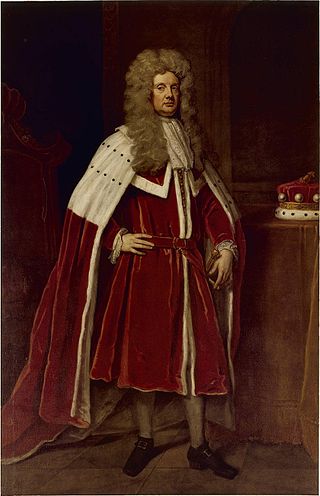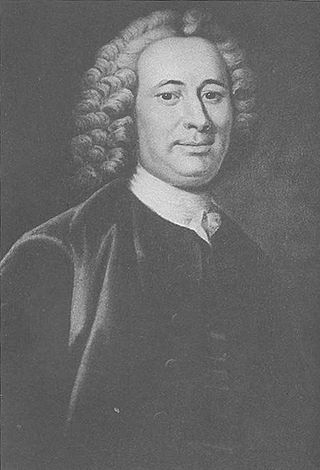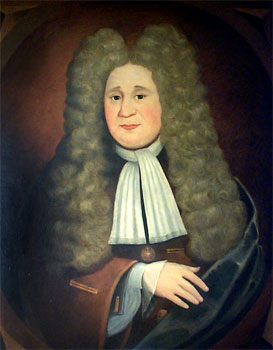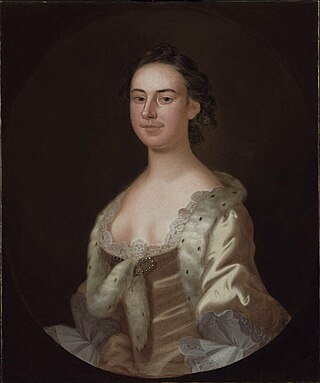
Charles Carroll, known as Charles Carroll of Carrollton or Charles Carroll III, was an American politician, planter, and signatory of the Declaration of Independence. He was the only Catholic signatory of the Declaration and the longest surviving, dying 56 years after its signing.

Charles Carroll was an American statesman from Annapolis, Maryland. He was the builder of the Baltimore Colonial home Mount Clare (1760), and a delegate to the Second Continental Congress in 1776 and 1777.

Daniel Carroll was an American politician and plantation owner from Maryland and one of the Founding Fathers of the United States. He supported the American Revolution, served in the Confederation Congress, was a delegate to the Philadelphia Convention of 1787 which penned the Constitution of the United States, and was a U.S. Representative in the First Congress. Carroll was one of five men to sign both the Articles of Confederation and the Constitution. He was one of the few Roman Catholics among the Founders.

Charles Calvert, 3rd Baron Baltimore, inherited the colony of Maryland in 1675 upon the death of his father, Cecil Calvert, 2nd Baron Baltimore, (1605–1675). He had been his father's Deputy Governor since 1661 when he arrived in the colony at the age of 24. However, Charles left Maryland for England in 1684 and would never return. The events following the Glorious Revolution in England in 1688 would cost Calvert his title to Maryland; in 1689 the royal charter to the colony was withdrawn, leading to direct rule by the British Crown. Calvert's political problems were largely caused by his Roman Catholic faith which was at odds with the established Church of England.

Benedict Leonard Calvert, 4th Baron Baltimore was an English peer and politician. He was the second son of Charles Calvert, 3rd Baron Baltimore (1637–1715) by Jane Lowe, and became his father's heir upon the death of his elder brother Cecil in 1681. The 3rd Lord Baltimore was a devout Roman Catholic, and had lost his title to the Province of Maryland shortly after the events of the Glorious Revolution in 1688, when the Protestant monarchs William III and Mary II acceded to the British throne. Benedict Calvert made strenuous attempts to have his family's title to Maryland restored by renouncing Roman Catholicism and joining the Church of England.

Colonel Thomas Brooke Jr. of Brookefield was President of the Council in Maryland and acting 13th Proprietary Governor of the Province of Maryland. He was the son of Major Thomas Brooke Sr. and Esquire (1632–1676) and his second wife Eleanor Hatton (1642–1725) who later remarried Col. Henry Darnall (1645-1711). He was grandson of the Reverend Robert_Brooke_Sr. who also held the office briefly during the Cromwellian period in 1652.

Major Thomas Brooke Sr., Esq. was a colonial lawyer, planter and politician of Calvert County, Maryland, where he served in the appointed positions of Burgess, High Sheriff and Chief Justice.

Darnall's Chance, also known as Buck House, Buck-Wardrop House, or James Wardrop House, is a historic home located at 14800 Governor Oden Bowie Drive, in Upper Marlboro, Prince George's County, Maryland, United States.

Melwood Park is a historic home located near Upper Marlboro in Prince George's County, Maryland, United States. It is a 2+1⁄2-story, Flemish bond brick structure, with Georgian details. As of 2009, it is undergoing an extensive restoration. This unique dwelling was visited by George Washington on several occasions and the British Army camped here during their march to Washington, D.C. in August 1814, during the War of 1812.
George Hume Steuart, (1700–1784) was a Scottish physician, tobacco planter, and Loyalist politician in colonial Maryland. Born in Perthshire, Steuart emigrated to Maryland in around 1721, where he benefited from proprietarial patronage and was appointed to a number of colonial offices, eventually becoming a wealthy landowner with estates in both Maryland and Scotland, and serving two terms as mayor of Annapolis. However, he was forced by the outbreak of the American Revolution to decide whether to remain loyal to the Crown or to throw in his lot with the American rebels. In 1775 Steuart sailed to Scotland, deciding at age 75 that "he could not turn rebel in his old age". He remained there until his death in 1784.

Charles Carroll II (1702–1782) known as Charles Carroll of Annapolis to distinguish him from his similarly named relatives, was a wealthy Maryland planter and lawyer. His father was Charles Carroll the Settler,, (1661–1720), an immigrant to Maryland who had arrived in the colony in 1689 with a commission as Provincial Attorney General, and had accumulated a vast fortune, emerging as Maryland's wealthiest citizen. Charles Carroll of Annapolis inherited and extended his father's fortune but, as a Roman Catholic, was barred from participation in Maryland politics. It would fall to his son, Charles Carroll of Carrollton, (III), (1737–1832), one of the signers of the Declaration of Independence, to see religious toleration restored to Maryland and many political and scientific/technological advances in the newly independent state.

Charles Carroll (1661–1720), sometimes called Charles Carroll the Settler to differentiate him from his son and grandson, was a wealthy lawyer and planter in colonial Maryland. Carroll, a Catholic, is best known because his efforts to hold office in the Protestant-dominated colony resulted in the disfranchisement of the colony's Catholics.

John Carroll was an American prelate of the Catholic Church who served as the first bishop of the Diocese of Baltimore, the first diocese in the new United States. He later became the first archbishop of Baltimore. Until 1808, Carroll administered the entire American Catholic Church.

Colonel Henry Darnall was a planter, military officer and politician in colonial Maryland. Darnall served as the Proprietary Agent in the colony for Lord Baltimore; he also briefly served as Deputy Governor of Maryland. During the Protestant Revolution of 1689, his proprietarial army was defeated by the Protestant army of John Coode, and he was stripped of his numerous colonial offices as a result. Darnall died in 1711, leaving the bulk of his substantial estates to his son, Henry Darnall II.

Elizabeth Calvert (1731–1788) was the daughter of Maryland Governor Captain Charles Calvert and Rebecca Gerard, and a wealthy heiress in colonial Maryland. Her parents died when she was young, leaving her their substantial fortune. In 1748, aged 17, she married her cousin Benedict Swingate Calvert, a Loyalist politician and planter and the illegitimate son of Charles Calvert, 5th Baron Baltimore. Benedict's connections to the ruling Calvert family allowed him to benefit from considerable proprietarial patronage, until the American Revolution saw the overthrow of British rule and the end of Calvert power in Maryland. Benedict and Elizabeth had to pay triple taxes after the war's end but, unlike many loyalists, their lands and fortune remained unconfiscated.

Laetitia "Lettice" Lee, also known as Lettice Lee Wardrop Thompson Sim, was an American colonial planter, society hostess, slaveowner, and châtelaine of Darnall's Chance. A member of the prominent Lee family of Virginia and Maryland, she lived a privileged life typical for members of the planter class. Unusual for her time, Lee was married three times; first to James Wardrop, then Adam Thompson, and lastly to Colonel Joseph Sim. She lived at Darnall's Chance for the second half of her life, throughout all three of her marriages.
Colonel William Digges was a prominent planter, soldier and politician in the Colony of Virginia and Province of Maryland. The eldest son of Edward Digges (1620-1674/5), who sat on the Virginia Governor's Council for two decades but died shortly before Bacon's Rebellion, Digges fled to Maryland where he married Lord Calvert's stepdaughter and served on the Maryland Proprietary Council until losing his office in 1689 during the Protestant Revolution, when a Puritan revolt upset the Calvert Proprietorship. His eldest son Edward sold his primary Virginia plantation to his uncle Dudley Digges. It is now within Naval Station Yorktown. His former Maryland estate, Warburton Manor, is now within Fort Washington Park. Two additional related men with the same name served in the Virginia General Assembly, both descended from this man's uncle and his grandson Cole Digges (burgess): William Digges (burgess) and his nephew and son-in-law William Digges Jr. both represented now-defunct Warwick County, Virginia.
Henry Darnall II (1682-1759) was a wealthy Roman Catholic planter in Colonial Maryland. He was the son of the politician and planter Henry Darnall, who was the Proprietary Agent of Charles Calvert, 3rd Baron Baltimore, and served for a time as Deputy Governor of the Province. During the Protestant Revolution of 1689, Henry Darnall I's proprietarial army was defeated by the Puritan army of Colonel John Coode, and he was stripped of his numerous colonial offices. After his father's death, Henry Darnall II did not enjoy political power in Maryland, but he remained wealthy thanks to his family's extensive estates. He married twice, fathering many children. His eldest son Henry Darnall III (c1702-c1783) inherited the bulk of what remained of his estates, and one of his grandchildren, Daniel Carroll, would become one of the Founding Fathers of the United States. A small portion of Darnall's former property, now called Darnall's Chance, can still be visited today.

Henry Darnall III was a wealthy planter in Colonial Maryland. He was the son of the politician and planter Henry Darnall II, and the grandson of Henry Darnall who was the Proprietary Agent of Charles Calvert, 3rd Baron Baltimore (1605–1675), and served for a time as Deputy Governor of the Province. Henry Darnall III converted to Anglicanism and entered politics at a time when the Calvert family had regained their proprietary colony, having lost it during the Protestant Revolution of 1689. Darnall received much criticism for his faith and was accused of being a secret Catholic. Worse, in 1761 he was accused of embezzling almost £1,000 thanks to his position as Naval Officer of the colony, and was forced to flee Maryland for Europe in order to avoid being placed on trial.
Justus Engelhardt Kühn (unknown-c1717) was a portrait painter active in colonial Maryland in the early part of the eighteenth century. He was the earliest professional artist to work in the Middle Atlantic colonies. A number of his portraits are held in the collection of the Maryland Historical Society.















